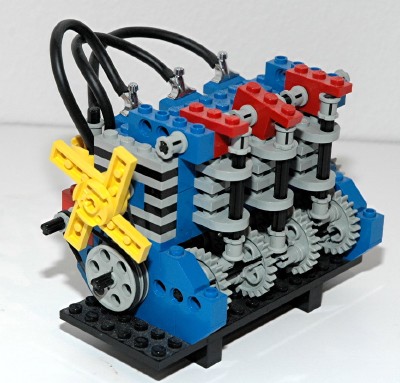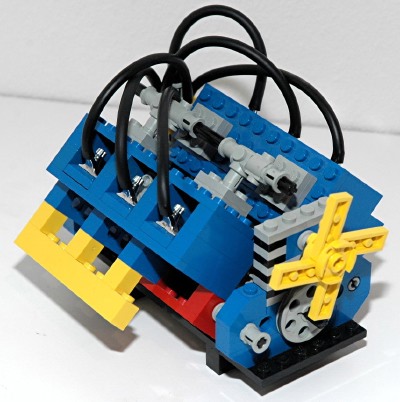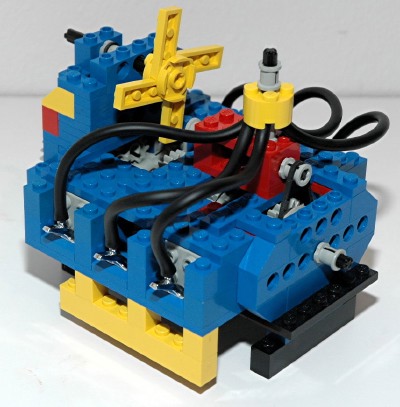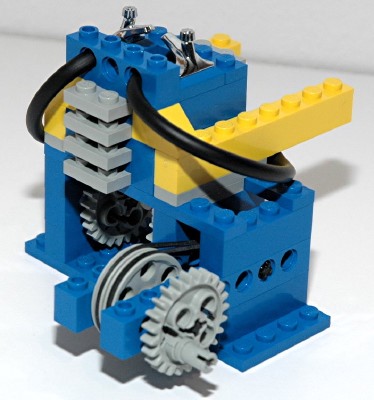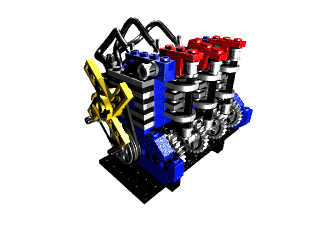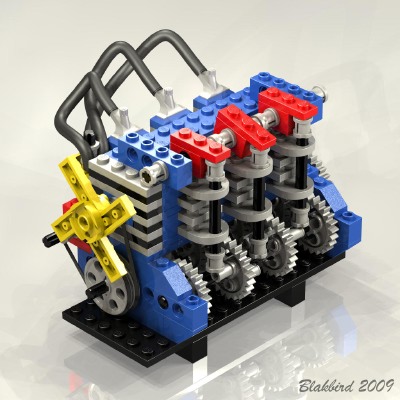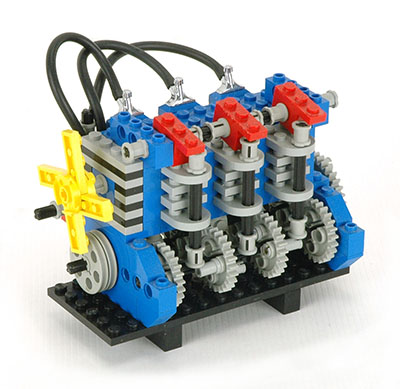Features
|
|
Inline Engine
This engine is an inline 3-cylinder gasoline engine. How can I
tell it is gasoline? Because it has spark plugs!
The engine uses the offset axle holes of the 24 tooth gears to make a
crankshaft. Due to the gear design, the crankshaft is flat plane,
rather than clocking the crank pins 120° as a real 3 cylinder
would do. Connectors placed end to end and clocked 90°
form rods which connect to 3 specialized 2x2 square pistons. The
"cylinders" are actually square. The engine is driven by a
40 tooth flywheel on the back end. On the front are a pair of
pulleys (first seen in this model) which drive belts. One belt
drives the fan, while another drives the distributor.
Running parallel to the crankshaft is a cam shaft with 4-24 tooth
gears. Pins are present in the offset holes of the gears.
These pins act as lifters which drive push rods running up to tappets
and rockers on the head. The push rods are guided by new 3x2
plates with centered holes at one end. The cam shaft and the crank
shaft rotate at the same speed but, due to two pins being in each gear,
the rods cycle twice for every rotation of the crank shaft. This
makes it kind of like a 4 cycle engine except that the same valve opens
twice. Is it an exhaust valve or an intake valve? It
doesn't matter. This is the only LEGO® engine with
valves of any kind, so I'm just glad they are there. Due to the
way the lifters hit the push rods, the engine can only be rotated one
direction (clockwise). It will jam in the other direction.
There are also a number of aesthetic features which do not actively
function. The distributor features spark plug wires which run to
each cylinder. Faucet parts are used for plugs. There are
air cooling fins on each cylinder. An exhaust manifold runs down
one side.
This engine is unlike any other made by LEGO® before or
since, and is one of my favorites.
|
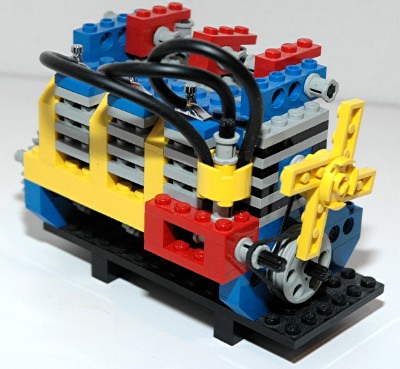
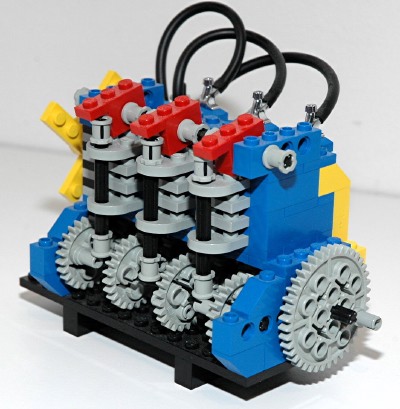
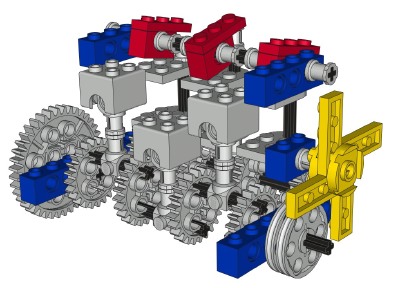
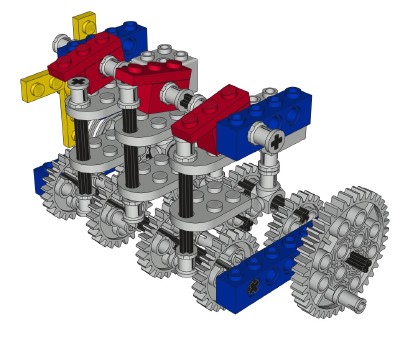
Click for an animation of the inline
engine in motion.
|
|
V6 Engine
This engine is a 6 cylinder "V", with the cylinder banks angled
approximately 90° from each other. This type of engine is
commonly used in automobiles, but 90° banks are seldom used on
V6s due to vibration induced from imbalance.
The function of the pistons is as described above, except that there
are two cylinder banks. Most V6's have a separate crank pin for
each piston, but this crank has just 3 crank pins, so each pair of
opposite pistons share one. One oddity of these piston parts is
that they sit side by side on the crank and do not overlap. The
effect of this is that the cylinders on the right side are offset one
stud from the cylinders on the left making the block asymmetric.
This engine also has a belt driven fan and belt driven cam which runs
along one side but does not attach to any valves. The distributor
and plug wires are as described above. This engine also appears
to have dual exhaust, or at least no Y-pipe is present.
|
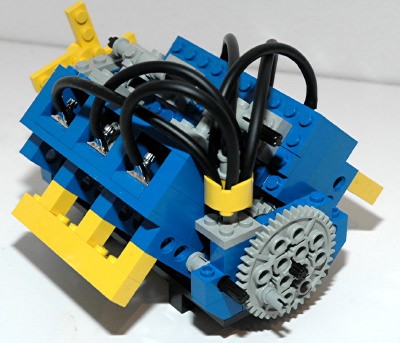
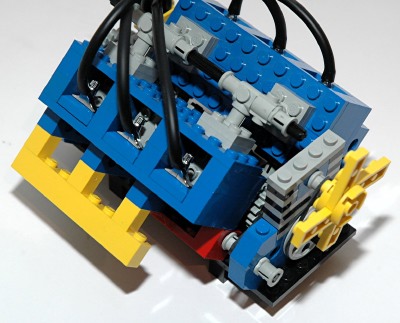
Click for an animation of the V-6 engine
in motion. |
|
Boxer Engine
This engine is a horizontally opposed 6-cylinder gasoline engine.
LEGO® calls it a "boxer" engine, and it looks like one,
but technically it isn't. A real boxer has opposing pistons reach
top dead center at the same time. This engine uses a flat plane
crankshaft, so opposing pistons are 180° out of phase, as can be
seen in the computer image. Note that LEGO has never made a
cross plane crank, even with the newer engine parts, so a realistic V8
still remains elusive.
The function of the pistons is as described above, and has the same
type (in fact the same assembly) offset cylinder banks as the V6.
This engine has an overhead belt driven fan and distributor. The
belts are actually inside the block, making them very difficult to
install. This is the only instruction I can recall which actually
shows using a bent paper clip as the correct method of
installation. If the paper clip slips off the rubber band, you
have to tear apart the whole engine to get it back out.
|
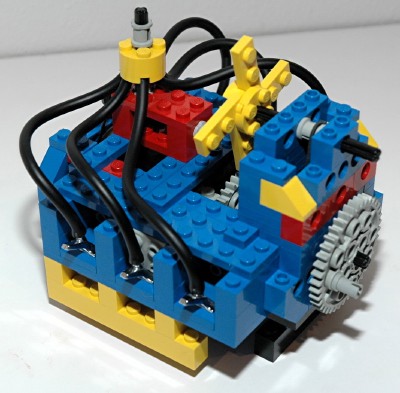
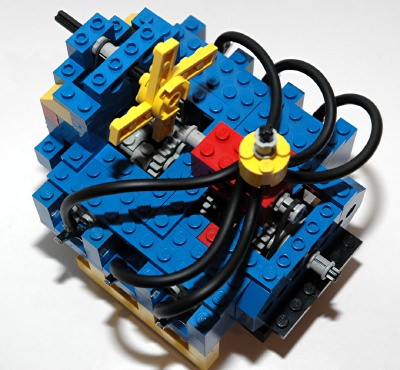
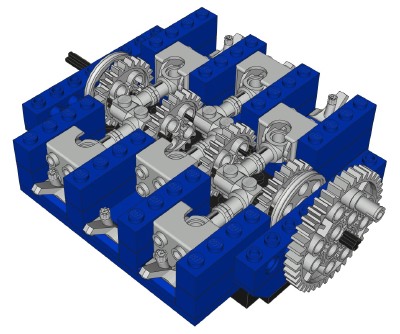
Click for an animation of the boxer
engine in motion.
|
|
2 Cycle Engine
This single cylinder, 2 cycle, fuel scavenging engine is the type which
might be seen in a lawn mower or pressure washer. There are no
exhaust or fuel transfer ports, so it cannot technically be determined
to be a 2 cycle, but it looks like one. If not for the spark
plugs, this might have been a diesel or nitro burning engine.
The piston is belt driven from a pulley, which makes this engine turn
about 4 times per revolution of the input crank.
|
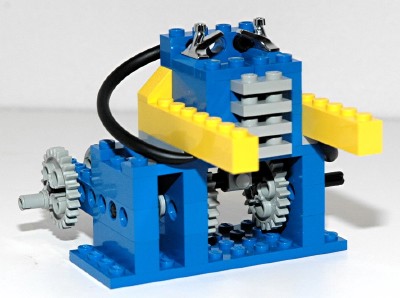

Click for an animation of the 2-cycle
engine in motion. |

